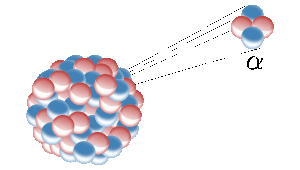Astatine
Elemental astatine has never been viewed, because a mass large enough to be seen (by the naked human eye) would be immediately vaporized by the heat generated by its own radioactivity. Astatine may be dark, or it may have a metallic appearance and be a semiconductor, or it may even be a metal. It is likely to have a much higher melting point than does iodine, on par with those of bismuth and polonium. Chemically, astatine behaves more or less as a halogen, being expected to form ionic astatides with alkali or alkaline earth metals; it is known to form covalent compounds with nonmetals, including other halogens. It does, however, also have a notable cationic chemistry that distinguishes it from the lighter halogens. The second longest-lived isotope of astatine, astatine-211, is the only one currently having any commercial application, being employed in medicine to diagnose and treat some diseases via its emission of alpha particles (helium-4 nuclei). Only extremely small quantities are used, however, due to its intense radioactivity.
The element was first produced by Dale R. Corson, Kenneth Ross MacKenzie, and Emilio Segrè at the University of California, Berkeley in 1940. They named the element "astatine", a name coming from the great instability of the synthesized matter (the source Greek word αστατος (astatos) means "unstable"). Three years later it was found in nature, although it is the least abundant element in the Earth's crust among the non-transuranic elements, with an estimated total amount of less than 28 grams (1 oz) at any given time. Six astatine isotopes, with mass numbers of 214 to 219, are present in nature as the products of various decay routes of heavier elements, but neither the most stable isotope of astatine (with mass number 210) nor astatine-211 (which is used in medicine) is produced naturally.
Natural occurrence
Astatine is the rarest naturally occurring element that is not a transuranic element, with the total amount in Earth's crust estimated to be less than 28 grams (1 oz) at any given time. Any astatine that was present at the Earth's formation has long since decayed, and the minute amounts of astatine existing currently have formed through the decay of heavier elements. While it was previously thought to be the rarest element occurring on the Earth, astatine has lost this status to berkelium, atoms of which can be produced by neutron capture reactions and beta decay in very highly concentrated uranium-bearing deposits.
Six astatine isotopes occur naturally (astatine-214 to astatine-219). Because of their short half-lives, they are found only in trace amounts. There is no data indicating that astatine occurs in stars.
Four out of these isotopes (astatine-215, astatine-217, astatine-218, and astatine-219) are found due to their production in major natural decay chains. Francium-223, the father isotope of astatine-219, alpha decays with a probability of only 0.006%, making this astatine isotope extremely rare even compared to the other astatine isotopes; this is in spite of its half-life being the longest of the natural astatine isotopes (56 seconds). Astatine-219 decays to polonium-215, which itself beta decays to astatine-215 with an even smaller probability of 0.00023%. The entirety of North and South America combined, considered to a depth of 16 kilometers (10 miles), contain only about one trillion astatine-215 atoms at any given time.Astatine-218 is found in nature as a result of polonium-218 beta decay; as with francium-223 and polonium-215, decay to an astatine isotope is not the primary decay mode. However, the astatine-217 isotope has a straight chain leading directly to astatine; its father isotope (francium-221) decays exclusively to this nuclide. Given that its fathers, grandfathers, and so on each decay exclusively to only one nuclide, this gives only one possible way for the starting nuclide in the neptunium series (neptunium-237) to decay – via eventual production of astatine-217.
The isotopes with mass numbers 214 through 216 are found as the result of triple alpha decay of the naturally present protactinium isotopes protactinium-226, protactinium-227, and protactinium-228.However, these isotopes are extremely rare, so much so that they are often not cited as natural astatine isotopes.
| Symbol | At | |
| Atomic Number | 85 | |
| Atomic Weight | 209.9871 | |
| Oxidation States | ||
| Electronegativity, Rochow | 1.96 | |
| State at RT | solid | |
| Melting Point, K | 575 | |
| Boiling Point, K | 610 |
Appearance and Characteristics
Harmful effects:
Highly radioactive
Characteristics:
- Astatine is highly radioactive and is only available in tiny quantities. Its properties are inferred from its position in the periodic table and by studying its chemistry in extremely dilute solutions.
- Like the other halogens, astatine would be expected to form salts with metals such as sodium. Astatine can also react with hydrogen to form hydrogen astatide, which when dissolved in water, forms hydroastatic acid.
- Astatine is the least chemically reactive of the halogens and exhibits the most metallic properties of the halogen group.
Uses of Astatine
- Astatine-211 is sometimes used as a radioactive tracer and in cancer treatment.
- Like iodine, it is known to accumulate in the thyroid gland.
